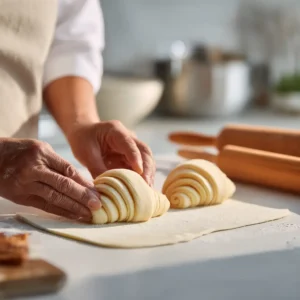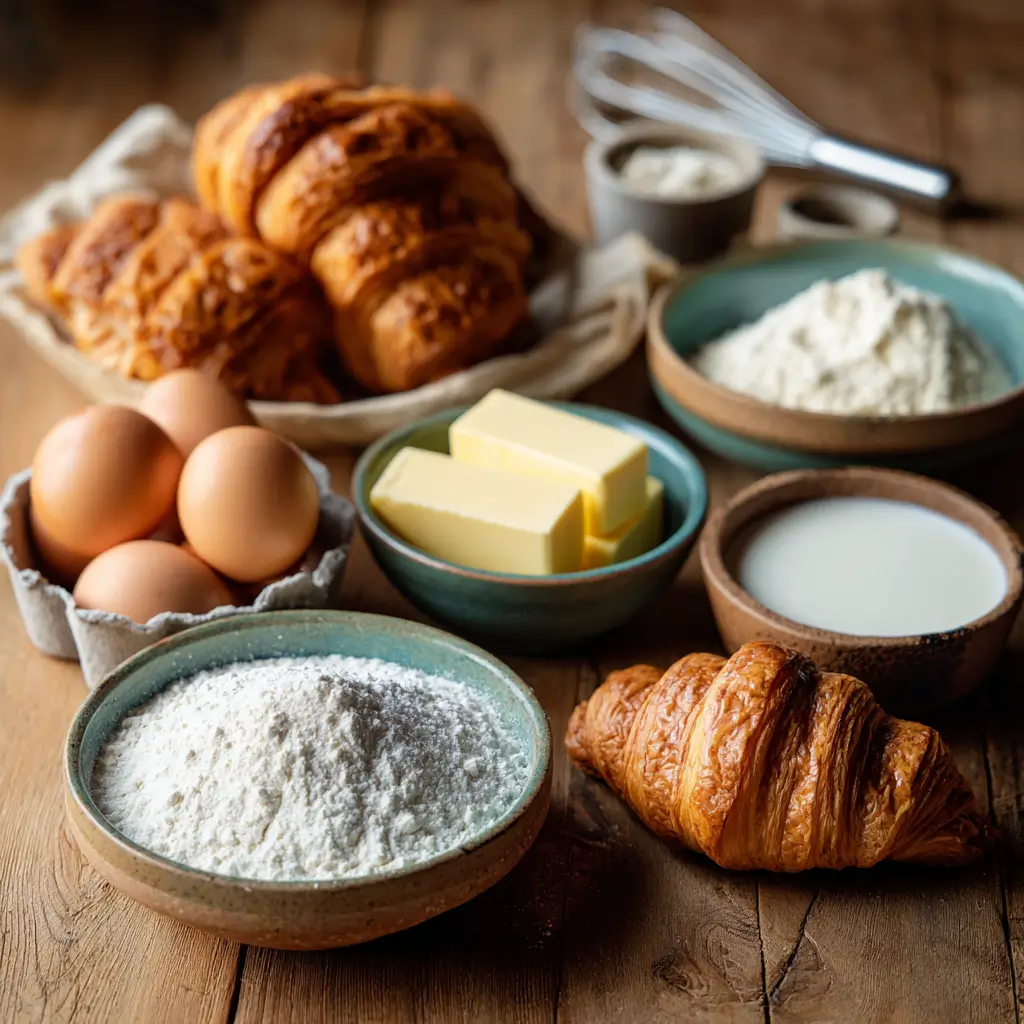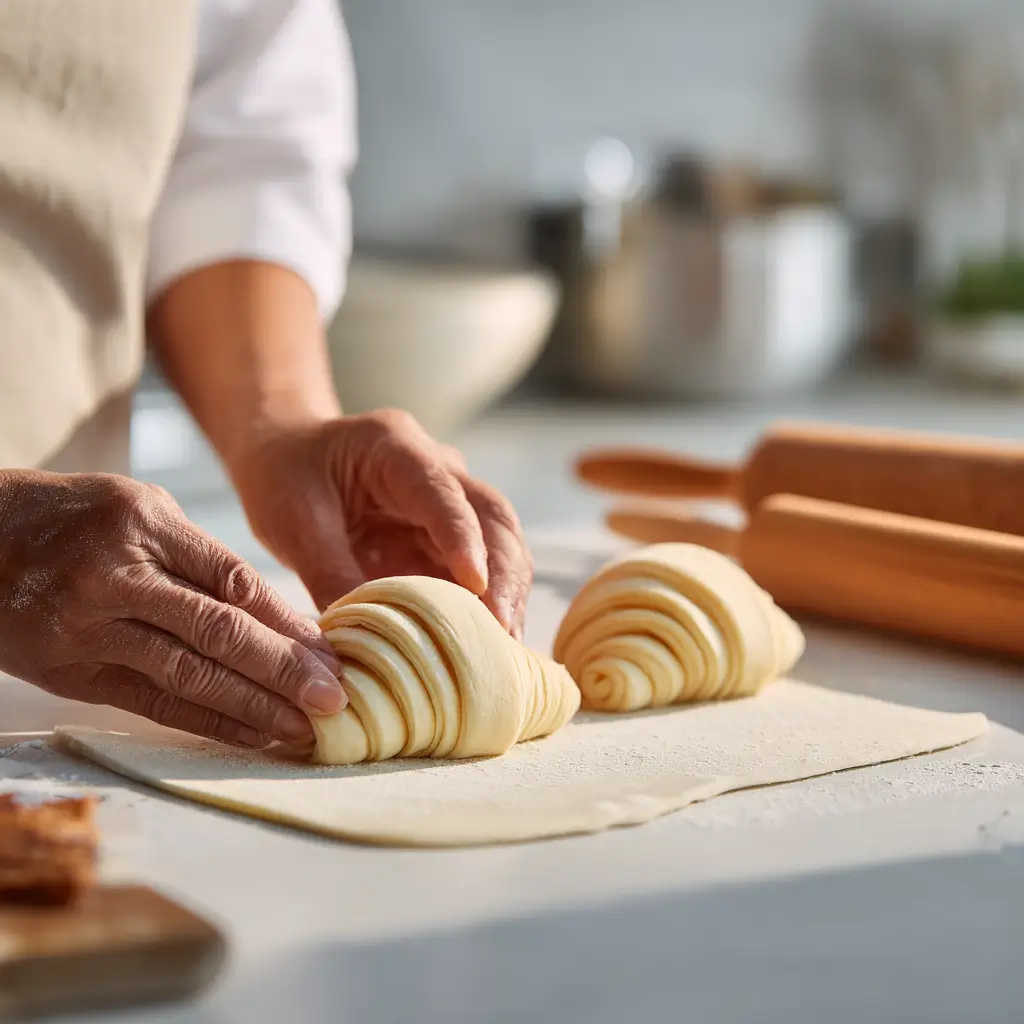If you’ve ever dreamed of mastering buttery, flaky croissants right in your home kitchen, the Claire Saffitz croissant recipe might just be your golden ticket. Want a whole grain twist? Don’t miss our guide to the Claire Saffitz spelt croissant recipe for a healthier, nutty variation.
Known for her attention to detail and accessible gourmet flair, Claire’s recipe is a true labor of love. From prepping a supple détrempe to skillfully folding the butter block, each step teaches you the real art of laminated dough.
Table of Contents
In this article, we’ll walk you through her exact process, ingredient choices, step-by-step techniques, and expert tips. Whether you’re a baking novice or a seasoned enthusiast, this guide will equip you with everything you need to make bakery-quality croissants. Looking for inspiration? Try our dairy-free cream recipe if you’re planning to skip dairy while keeping it indulgent.
Claire Saffitz Croissant Recipe PDF
PrintClaire Saffitz Croissant Recipe PDF
Master the art of French pastry at home with this detailed, step-by-step recipe inspired by Claire Saffitz. These flaky, buttery croissants deliver a bakery-quality experience and are perfect for weekend baking projects.
- Prep Time: 1 hour
- Cook Time: 0,20 hour
- Total Time: 1,20 hour
- Yield: 8 large croissants
- Category: Baked Goods
- Method: Laminated Dough
- Cuisine: French
- Diet: Vegan
Ingredients
For the Détrempe (Dough):
4⅔ cups (605g) all-purpose or bread flour (plus more for dusting)
⅓ cup (66g) granulated sugar
1 tbsp + ½ tsp (12g) kosher salt
2¼ tsp (7g) active dry yeast
¾ cup + 2 tbsp (214g) water, at room temperature
½ cup (120g) whole milk, at room temperature
¼ cup (57g) unsalted butter, chilled and cut into ½-inch pieces
For the Butter Block and Assembly:
1½ cups (340g) European-style unsalted butter (3 sticks), chilled
All-purpose flour (for rolling)
1 large egg yolk
1 tbsp heavy cream

Instructions
Make the Dough (Détrempe):
In a large bowl, combine flour, sugar, salt, and yeast. Add water and milk, stirring to form a shaggy dough. Mix in butter pieces until just incorporated. Knead briefly, shape into a rectangle, wrap, and refrigerate overnight.Prepare the Butter Block:
Form butter into a 6×6-inch square between parchment sheets. Chill until firm but pliable.Laminate the Dough:
Roll the dough into a 12×12-inch square. Place butter in the center (diamond orientation), fold corners over to enclose. Roll into a long rectangle and complete 3 single folds (letter-style), chilling between each fold.Shape the Croissants:
Roll laminated dough into a large rectangle. Cut into triangles and roll tightly from base to tip. Curve ends inward slightly.Proof the Croissants:
Place on lined baking sheet and let rise at room temperature 1.5–2 hours until doubled in size and puffy.Bake:
Preheat oven to 375°F (190°C). Mix egg yolk and cream, brush over croissants. Bake 18–22 minutes or until deeply golden and crisp. Let cool slightly before serving.

Notes
Use European-style butter for best results due to its high butterfat content.
Keep butter and dough at similar temperatures during folding.
You can freeze shaped, unbaked croissants before final proofing for future baking.
Nutrition
- Serving Size: 1 croissant
- Calories: 410
- Sugar: 4g
- Sodium: 420mg
- Fat: 24g
- Saturated Fat: 15g
- Unsaturated Fat: 8g
- Trans Fat: 0g
- Carbohydrates: 42g
- Fiber: 2g
- Protein: 7g
- Cholesterol: 75mg
Introduction to Claire Saffitz and Her Legendary Croissant Recipe
Who is Claire Saffitz?
Claire Saffitz is a culinary phenomenon. A professionally trained pastry chef, cookbook author, and YouTube sensation, she’s become a household name thanks to her precise, no-nonsense yet warm approach to baking. Formerly a star on Bon Appétit’s Gourmet Makes, Claire has since launched her own video series and released a bestselling cookbook.
Her fans love her not just for her baking skills but for her relatable demeanor. Claire demystifies complex pastry projects, and her croissant recipe is no exception—it’s gourmet-level baking made feel doable.
Why Her Croissant Recipe Became Iconic
So what sets Claire’s croissant recipe apart from others? First, it sticks closely to French tradition while streamlining steps for the home baker. She focuses on key techniques like consistent butter folds and proper proofing, emphasizing patience over shortcuts.
Moreover, Claire’s emphasis on European-style butter, high-protein flour, and temperature control means the result is a croissant that’s both rich and delicate. The crispy outer layers shatter on bite, revealing a honeycomb interior that’s pure pastry perfection. Unlike some versions, her method doesn’t overload you with unnecessary steps or tools—just what works.
From her fans to professional bakers, many have called it the best homemade croissant recipe online. Want to explore more Claire Saffitz-style magic? Check out our comforting dairy-free cream of chicken soup for another cozy classic reimagined.
Ingredients You’ll Need for the Claire Saffitz Croissant Recipe

Full Breakdown of Détrempe and Butter Block Ingredients
To achieve the layered perfection that makes croissants truly exceptional, you’ll need to use quality ingredients in precise amounts. Below is the original list from Claire Saffitz’s croissant recipe, separated into two essential components: the détrempe (dough) and the butter block.
| Ingredient | Quantity | Notes |
|---|---|---|
| All-purpose or bread flour | 4⅔ cups / 605 grams | Choose high-protein for stronger gluten development |
| Granulated sugar | ⅓ cup / 66 grams | Sweetens the dough just enough |
| Kosher salt | 1 tbsp + ½ tsp / 12 grams | Enhances flavor |
| Active dry yeast | 2¼ tsp / 7 grams | Helps the dough rise slowly |
| Water (room temp) | ¾ cup + 2 tbsp / 214 grams | Key for hydration and gluten |
| Whole milk (room temp) | ½ cup / 120 grams | Adds richness and tender crumb |
| Unsalted butter (chilled) | ¼ cup / 57 grams | Incorporated into the dough |
For the Butter Block and Assembly:
| Ingredient | Quantity | Notes |
|---|---|---|
| European-style butter | 1½ cups / 340 grams (3 sticks) | Higher fat content, ideal for lamination |
| All-purpose flour | As needed | Used to prevent sticking during rolling |
| Egg yolk | 1 large | Used for egg wash |
| Heavy cream | 1 tbsp | Mixed with yolk for a golden, shiny finish |
Claire recommends European-style butter specifically because of its high butterfat and lower moisture—this ensures better lamination, flakier texture, and minimal leakage during baking.
Pro Tip: Always keep your butter and dough cold between folds. Warm butter will melt out and destroy the layered structure you’re working hard to create.
Best Substitutions for Dairy-Free or Allergen-Friendly Versions
Want to enjoy claire saffitz croissant Recipe without dairy? It’s possible to adapt the Claire Saffitz croissant recipe while maintaining delicious flakiness.
Here are some substitutions:
| Original Ingredient | Dairy-Free Alternative |
|---|---|
| Whole milk | Oat milk or almond milk (unsweetened) |
| Heavy cream | Coconut cream or soy cream |
| Butter (for lamination) | Vegan butter sticks (e.g. Miyoko’s or Earth Balance Baking Sticks) |
| Egg yolk (egg wash) | Plant-based milk + maple syrup mix |
Keep in mind that texture and rise may differ slightly when using non-dairy ingredients. But the flavor can still be fantastic—especially when paired with options like our dairy-free cupcakes for dessert.
Want to explore other allergen-friendly recipes? Discover great ideas like dairy-free chocolate chip cookies to stock your baking rotation.
Tools and Equipment for Croissant Success
Essential Tools for Croissant Prep and Baking
Making croissants from scratch, especially a recipe as detailed as Claire Saffitz’s, demands precision. The right tools can make or break your success. Here’s a curated list of kitchen essentials that will help you nail claire saffitz croissant Recipe from day one.
| Tool | Purpose |
|---|---|
| Digital kitchen scale | For accurate flour, water, and butter measurements |
| Rolling pin | Key to laminating the dough and shaping croissants |
| Baking sheet (rimmed) | Provides support during proofing and baking |
| Parchment paper | Prevents sticking and keeps croissants intact |
| Plastic wrap | Essential for resting and refrigerating dough |
| Bench scraper | Helps cut and manipulate the dough cleanly |
| Ruler or measuring tape | Ensures consistent dough dimensions during folding |
| Pastry brush | Applies egg wash evenly for that golden finish |
Many of these are kitchen staples, but if you’re serious about mastering laminated dough, a few extra investments will make the process smoother.
Expert Note: If your kitchen runs warm, work near a window or use frozen sheet pans to chill dough between steps.
Kitchen Upgrades to Make Laminating Easier
Croissants are all about temperature control and technique. While you don’t need professional bakery equipment, here are some helpful upgrades that bring consistency and ease:
- Marble Pastry Board: Keeps dough cooler longer during rolling
- Silicone Rolling Mat: Gives better grip and measurements
- Cooling Racks: Ensures air circulates beneath croissants for even baking
- Stand Mixer with Dough Hook: Speeds up mixing and helps develop gluten evenly
- Thermometer (Infrared or Probe): Monitors dough, butter, and oven temps
Croissants don’t forgive shortcuts, and Claire Saffitz’s recipe honors the French technique. But with the right tools, even a beginner can deliver bakery-level results at home.
Don’t miss our tips in the dairy-free banana bread guide, where we explain how tools affect baking consistency, too.
Step-by-Step Process to Make Claire Saffitz Croissants

Preparing the Dough (Détrempe)
The base of every great croissant is the détrempe—a rich yeasted dough. Claire’s version is soft, easy to work with, and perfectly balanced between elasticity and tenderness.
Steps to Prepare the Dough:
- Mix dry ingredients: In a large bowl, whisk together flour, sugar, salt, and yeast. Be sure the yeast and salt don’t touch directly.
- Add wet ingredients: Pour in water and milk, then stir to form a shaggy dough.
- Incorporate butter: Add cold, cubed butter and knead until mostly smooth—don’t overwork it.
- Initial proof: Cover with plastic wrap and let rise for about 1 hour at room temperature until just puffed.
- Chill: After the first proof, gently deflate and shape into a rectangle. Wrap tightly and refrigerate for at least 8 hours or overnight.
Tip: Keep the dough cold to ensure proper lamination later. This is especially important in warmer kitchens.
Making and Incorporating the Butter Block
This is where the real magic begins. The butter block, or beurrage, is what gives croissants their flaky, layered interior.
Steps to Prepare Butter Block:
- Form block: Arrange sliced butter between two sheets of parchment paper. Use a rolling pin to shape it into a 6×6-inch square.
- Chill: Place the square in the fridge until firm but pliable—not rock hard.
Enclosing the butter:
- Roll the chilled dough into a 12×12-inch square.
- Place the butter block in the center like a diamond, then fold the corners of the dough inward to encase the butter.
- Seal the seams gently but firmly. This ensures the butter doesn’t leak during lamination.
Rolling, Folding, and Laminating Like a Pro
Laminating is the art of folding butter into dough through multiple “turns” to create thin layers.
- First turn (single fold):
- Roll the dough into a long rectangle.
- Fold like a letter: bottom third up, top third down over it.
- Wrap and chill for 30 minutes.
- Second turn:
- Repeat rolling and folding the same way.
- Chill again for 30 minutes.
- Third turn:
- One final letter fold.
- Wrap and refrigerate the laminated dough for at least 1 hour before shaping.
This triple turn creates 27 distinct layers of butter and dough—essential for that honeycomb structure.
Shaping and Proofing Croissants
Shaping:
- Roll out the dough to about ¼-inch thick.
- Cut into long triangles (base about 3.5 inches wide).
- Stretch the base gently, then roll tightly from the base to the tip.
- Curve the ends inward into a crescent shape.
Proofing:
- Place croissants on a parchment-lined baking sheet.
- Let them proof in a warm, humid environment for 1.5–2 hours until doubled in size and wobbly when jiggled.
- They should feel light and puffy—not dense.
Want to serve these with a creamy topping? Check out our velvety dairy-free cream recipe.
Baking to Golden Perfection
Final steps:
- Preheat oven to 375°F (190°C).
- Egg wash: Mix egg yolk with cream. Gently brush the croissants for a glossy finish.
- Bake for 18–22 minutes or until deeply golden and puffed.
- Cool slightly before eating, but enjoy warm for the best texture.
Don’t miss our tips in the dairy-free pancakes guide to get fluffy textures just like this—minus the dairy.
Troubleshooting Common Croissant Mistakes
Flaky Fails: Overproofing, Under-Baking, and Tearing
Croissants are notoriously fussy—and for good reason. They’re a laminated pastry where texture, temperature, and time must align. Here’s how to identify and fix common baking errors:
1. Overproofing
- What happens: Croissants deflate or collapse in the oven.
- Why it happens: Overproofed croissants lose structure because gluten can’t support the air bubbles.
- Fix: Use the “jiggle test.” Proof until puffy but not weak. If they wobble gently when shaken, they’re ready.
2. Under-baking
- What happens: Croissants look golden but are raw inside.
- Why it happens: Oven temperature inconsistencies or taking them out too early.
- Fix: Bake at 375°F for 18–22 minutes, and tap the bottom—if it sounds hollow, they’re done.
3. Dough Tearing During Rolling
- What happens: Butter leaks, ruining lamination.
- Why it happens: Dough too cold or butter block too hard.
- Fix: Let the dough sit for 3–5 minutes at room temp if it cracks. Butter and dough should be the same consistency during rolling.
For equally delicate recipes that depend on timing and texture, check out our dairy-free chocolate chip cookies where moisture balance is just as critical.
How to Avoid Butter Leakage and Dough Collapse
Butter leakage is one of the most common lamination issues—and once it happens, there’s no going back.
Here’s how to prevent it:
- Keep butter pliable: Not melted, not hard. Aim for the texture of soft clay.
- Chill between every step: Even 10 minutes in the fridge helps reset structure.
- Seal edges completely: Gaps between folds give butter a chance to escape.
- Avoid warm hands: Your body heat can melt layers during folding. Work quickly or use a rolling pin with a cool handle.
Dough collapse during baking usually stems from poor layering or handling. To fix this:
- Don’t skip chilling between turns.
- Never press too hard with the rolling pin—you’ll crush the layers.
- Cut using a sharp knife or pizza wheel to avoid dragging the layers apart.
Want to practice handling delicate doughs? Don’t miss our dairy-free cupcakes where batter texture plays a big role in rise and crumb.
Flavor Variations Inspired by Claire Saffitz
Almond, Chocolate, and Savory Croissant Twists
Once you’ve mastered the classic Claire Saffitz croissant recipe, it’s time to get creative. While the original is a golden standard, Claire often inspires bakers to explore unique twists. Here are some irresistible variations you can try without compromising that flaky lamination.
1. Almond Croissants
- Filling: Mix almond flour, powdered sugar, butter, and a touch of almond extract into a frangipane paste.
- Assembly: After the croissants have proofed, slice open horizontally and pipe in the almond filling. Add more on top before baking.
- Bonus tip: Sprinkle with sliced almonds and dust with powdered sugar after baking.
2. Pain au Chocolat (Chocolate Croissants)
- Filling: Use two thin bars or sticks of high-quality dark chocolate (60-70% cocoa).
- Assembly: Instead of triangle cuts, slice dough into rectangles. Place chocolate near the bottom edge, roll once, then add another piece of chocolate before finishing the roll.
- Flavor enhancement: Brush with espresso-infused egg wash for a bitter-sweet aroma.

3. Savory Variants
- Cheese & Herb: Add shredded Gruyère or aged cheddar with fresh thyme or rosemary inside the rolled dough.
- Ham & Dijon: A slice of prosciutto and a dab of mustard go great in a savory brunch croissant.
- Caramelized Onion: Add a thin smear of slow-cooked onions for deep umami flavor.
Want the perfect sidekick to these croissants? Discover great ideas like dairy-free pancakes to complete your brunch spread.
How to Add Fillings Without Ruining the Lamination
Adding flavor shouldn’t sacrifice your layers. Here are some rules to follow:
- Always fold first, fill later: Complete all lamination turns before adding any filling.
- Keep fillings cold: Warm or runny fillings can melt the butter and ruin separation.
- Use thin layers: Don’t overstuff. It’s a croissant, not a sandwich.
- Seal edges well: This keeps your fillings inside during proofing and baking.
Looking for inspiration? Try our dairy-free banana bread if you want another make-ahead option that pairs beautifully with these variations.
With the right technique, you can turn Claire’s base recipe into a full-blown croissant menu worthy of a Parisian bakery—or your next Sunday brunch.
Serving, Storing, and Reheating Croissants
Best Ways to Serve Fresh Croissants
After putting in all the time and effort it takes to execute Claire Saffitz’s croissant recipe, you want to make sure they’re enjoyed at their absolute best.
Here’s how to serve croissants for max flavor and texture:
- Serve slightly warm: Fresh out of the oven is best, but if they’ve cooled slightly, a gentle reheat (more below) will restore that fresh-baked magic.
- Pair with high-quality butter or jam: Look for French salted butter or fruit preserves like raspberry or apricot.
- Make it a meal: Slice a croissant and add scrambled eggs, smoked salmon, or avocado for a luxurious breakfast sandwich.
Don’t miss our dairy-free cream of chicken soup—it’s the perfect savory pairing for a flaky, buttery croissant dinner roll upgrade.
| Best Pairings | Description |
|---|---|
| Raspberry or apricot jam | Adds tart-sweet contrast to buttery pastry |
| Fresh fruit + whipped cream | For a light, brunch-style plate |
| Cappuccino or espresso | Cuts through richness, adds café vibes |
| Fresh herbs or cheeses | Great for savory twists on the classic |
Storage Tips for Leftovers and Freezing Raw Dough
Croissants can be temperamental once baked, so storing them properly is key to preserving their texture.
For baked croissants:
- Room temperature: Store in an airtight bag for up to 2 days. Avoid the fridge—it makes them stale faster.
- Reheating: Pop in a 300°F oven for 5–7 minutes. This revives crispiness and softens the crumb.
- Microwaving? Only in a pinch. Use a low setting and avoid overheating or you’ll lose flakiness.
For unbaked, shaped croissants:
- Freeze after shaping and before proofing.
- Place croissants on a sheet tray, freeze until solid, then transfer to a freezer bag.
- When ready to bake, thaw overnight in the fridge, proof until doubled, then proceed as usual.
Want another make-ahead idea? Try our reader-favorite dairy-free cupcakes—easy to store and freeze just like croissants.
Freezing dough gives you the flexibility to enjoy bakery-quality croissants any time without starting from scratch.
How to Make the Claire Saffitz Croissant Recipe Dairy-Free
Why Make It Dairy-Free?
Whether you’re lactose-intolerant, vegan, or simply exploring alternative baking, transforming the Claire Saffitz croissant recipe into a dairy-free masterpiece is completely doable—and still incredibly flaky. Thanks to high-quality plant-based substitutes, you don’t have to compromise on texture or taste. The key is to match fat content and functionality, not just flavor.
Claire’s original method is rooted in traditional technique, but with a few strategic swaps, even home bakers can enjoy croissants that are 100% dairy-free.
Looking for more inspiration? Try our light and fluffy dairy-free pancakes for a full brunch setup.
Dairy-Free Swaps for Each Key Ingredient
To convert Claire’s croissant recipe, replace the following dairy-based ingredients:
| Original Ingredient | Dairy-Free Substitute | Notes |
|---|---|---|
| Whole milk | Oat milk or unsweetened almond milk | Richer plant milks mimic dairy better |
| Heavy cream (egg wash) | Coconut cream or soy cream | Use in mix with egg yolk or vegan alternative |
| Unsalted European butter | Vegan butter sticks (e.g., Miyoko’s) | Choose one with 80%+ fat for lamination |
| Egg yolk (optional) | Non-dairy milk + maple syrup glaze | Adds shine without dairy-based wash |
Don’t miss our indulgent dairy-free cream for a great brunch topping that complements flaky pastries beautifully.
Tips for Perfect Dairy-Free Lamination
Working without dairy does require a few adjustments:
- Use firm vegan butter: Look for ones made for baking, with high fat and low water. Earth Balance and Miyoko’s both perform well.
- Chill longer between folds: Vegan butters soften faster than dairy ones. Stick your dough in the fridge if the butter feels mushy.
- Roll gently: Vegan doughs can tear more easily—go slow and avoid over-handling.
Despite being dairy-free, the dough should still produce that beautiful laminated texture when proofed and baked correctly.
Final Flavor Notes
The taste of a dairy-free croissant will differ slightly—it may be a bit nuttier or less buttery depending on the brand of vegan butter used. But when done right, the difference is minimal and the results are incredibly satisfying.
Discover great ideas like these for a complete dairy-free bakery experience at home.
FAQs About Claire Saffitz Croissant Recipe
What makes Claire Saffitz’s croissant recipe different from others?
Claire Saffitz’s croissant recipe stands out because it blends authentic French technique with home-baker accessibility. Unlike many chef-level recipes that call for specialized equipment or complex jargon, Claire guides you with approachable instructions while preserving traditional methods like triple folds and extended proofing. She emphasizes ingredient quality, particularly using European-style butter and high-protein flour, which sets her version apart with a more layered texture and deeper flavor.
Plus, Claire’s signature touch? Patience. Her method respects the pastry process without shortcuts, allowing every layer to develop fully for a true croissant experience.
Can beginners make Claire Saffitz’s croissants successfully?
Yes, absolutely—if you follow the steps closely and give yourself enough time. claire saffitz croissant Recipe with the serious home baker in mind. While croissants are an advanced pastry, her explanations and pacing make it possible for motivated beginners to succeed.
Here’s what helps:
Use a digital scale to measure everything precisely
Keep butter and dough the same temperature throughout
Don’t rush the chilling or proofing stages
Expect a learning curve—your second batch will be even better than your first
It’s a weekend project, not a weeknight bake, but with patience and attention, it’s doable—and incredibly rewarding.
What’s the best butter to use for homemade croissants?
For the best results, Claire recommends European-style butter, which contains at least 82% butterfat. This higher fat content creates fewer water pockets, resulting in a dough that rolls smoothly and bakes into crisp, clean layers.
Some popular brands include:
Plugrá
Kerrygold (unsalted)
President
Vermont Creamery
If you’re making a dairy-free version, high-fat vegan alternatives like Miyoko’s Cultured Vegan Butter or Earth Balance Baking Sticks can substitute, though results may vary slightly in texture and rise.
Don’t miss our dairy-free cream guide if you’re planning to adapt this croissant recipe for dietary needs!
Conclusion
Mastering the Claire Saffitz croissant recipe is more than just following a set of steps—it’s embracing the art and rhythm of traditional French baking in your own kitchen. From understanding the role of butter lamination to perfecting proofing times, Claire’s method offers the ultimate homemade croissant blueprint for flaky, golden success.
Whether you’re enjoying them warm with jam, turning them into decadent almond croissants, or exploring dairy-free adaptations, the real joy comes from the layers of care you put into every fold.
Looking for your next pastry project? Don’t miss our guide on dairy-free chocolate chip cookies for a chewy, crowd-pleasing treat that’s just as satisfying.
Follow us for more dairy-free delights and kitchen-tested recipes:
Pinterest: NYT Recipe on Pinterest
Facebook: NYT Recipe on Facebook







